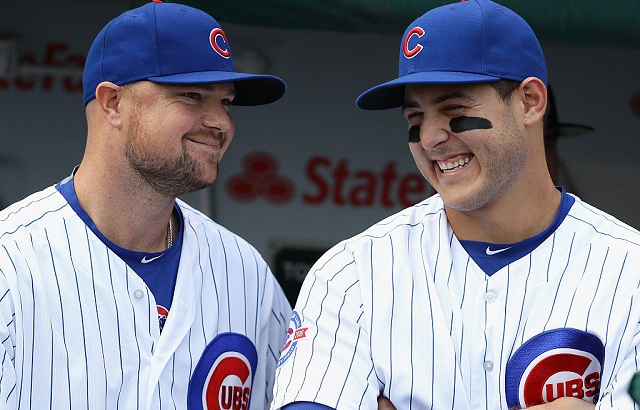The San Francisco Giants won the World Series in 2010. They also won it in 2012, and in 2014, so the next logical year in that pattern is… oh crap, 2016. After beating the New York Mets in the NL Wild Card game, the Giants have a tall task ahead of them in the Division Series: the Chicago Cubs, who had the best record in baseball this season and appear to be a team of destiny. Can the Giants work their even year magic once again?
It’ll be difficult for the Giants, and the main reason is that they won’t have ace Madison Bumgarner until Game 3 of the NLDS after burning him in the Wild Card game against the Mets. But that’s fine. San Francisco still has Johnny Cueto on the roster to start Game 1, and will go with (probably) Jeff Samardzija in Game 3. The Cubs will match reigning NL Cy Young winner Jake Arrieta up with Bumgarner in Game 3, going with Jon Lester against Cueto in Game 1 and Kyle Hendricks against Samardzija in Game 2.
The rotations are evenly matched, but a slight edge goes to the Cubs. Lester is coming off a year in which he threw 202 2/3 innings of 2.44 ERA ball. Hendricks tossed 190 innings of his own and had a minuscule 2.13 ERA. In a “down year,” Arrieta had a 3.10 ERA over 197 1/3 innings. Hell, even Chicago’s Game 4 starter, John Lackey, had a strong season. He pitched 188 1/3 innings and had a 3.35 ERA. Cueto and Bumgarner were brilliant in their own right, each crossing 200 innings while posting ERAs under 3.00, but Samardzija’s ERA was 3.81 over 203 1/3 innings and he had the lowest strikeout rate of any of these seven starting pitchers.
Chicago also has the better bullpen, led by closer Aroldis Chapman. Chapman saved 16 games and struck out 46 in his 26 2/3 innings as a Cub, allowing just three earned runs since his midseason trade from the Yankees. He’s backed up by C.J. Edwards, Hector Rondon, and Pedro Strop, a trio of fireballers who all struck out at least 10 batters per nine innings while limiting their walks. Throw in Trevor Cahill, Justin Grimm, and Travis Wood, and you have the makings of a bullpen that can go into shutdown mode at a moment’s notice.
San Francisco doesn’t have that luxury. Their best reliever is Derek Law, a rookie who pitched to a 2.13 ERA over 55 innings, striking out 50 and walking nine. Old standbys Santiago Casilla, George Kontos, Javier Lopez, and Sergio Romo are all still kicking it in the pen, but none inspire the confidence they once did during the Giants’ World Series runs of the past. A pair of new faces, rookie Steven Okert and trade deadline acquisition Will Smith, will also figure in, but none of the Giants relievers aside from Smith could really fit in with the Cubs bullpen.
Offensively, the Giants are a mess. They didn’t have one player this year hit 20 homers (Brandon Belt led the team with 17), score 100 runs (Buster Posey led with 82), or drive in 100 runs (Brandon Crawford led with 84). None of their hitters even cracked .290 for the year, and Belt was the only player within sniffing distance of a .400 OBP (he was at .394, while Posey in second was at .362). However, one thing the Giants did do well on offense as make contact. Only the Angels had a lower strikeout rate than their 17.7% mark, and only the Angels and Red Sox swung and missed at a lower rate than the Giants’ 9.0%.
As for the Cubs, their offense is dynamic, the best in the National League. They walk more than any other team. Only the Cardinals and Rockies hit for more power among National League clubs. Their strikeout rate was exactly league average. Two players launched 30 homers, and another one tacked on 20. Kris Bryant drove in and scored 100 runs, while Anthony Rizzo drove in 109 and scored 94. Addison Russell also drove in 95, while Ben Zobrist scored 94. Their only real weak spots are behind the plate, though Willson Contreras has solved that issue in the second half, and in right field, where Jason Heyward is still a mess offensively. There isn’t just one player you need to focus on in this Cubs lineup; there are multiple dangerous hitters that can doom a team.
The Cubs also possess a quality that can help neutralize the Giants’ lack of strikeouts: they’re the best defensive team in baseball by a country mile. Chicago saved 82 runs on the season via DRS, a whopping 31 more than the Astros in second place (and 32 more than the third place Giants). Their 73.7 UZR dwarfed the second-place Giants, who came in at 42.6 for the year. Their only below-average defensive regulars? Catcher Miguel Montero (again, an issue that Contreras took care of) and second baseman Ben Zobrist (known for his versatility and ability to play multiple positions, a theme on this year’s Cubs team). All of the other regulars are, at the very least, capable at their preferred position.
All right, now that I talked about how good the Cubs are and how they should steamroll the Giants, how can San Francisco win this series? They’re not going to outslug the Cubs, so they have to outpitch them. If Cueto, Samardzija, and Bumgarner all bring their A-games and don’t allow more than one or two runs per start, the Giants can scrape enough runs across the board to make this series competitive. If they don’t show up, something we’ve seen out of both Cueto and Samardzija in the past, this series could be a sweep, no matter how superhuman Bumgarner is in the Postseason.







